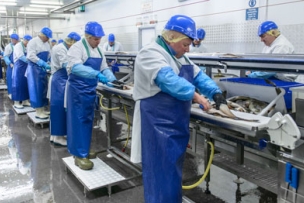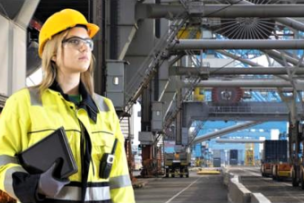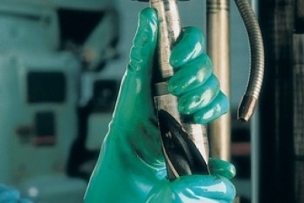Q&A: A Certified Workplace Safety Pro Talks PPE in Manufacturing
A longtime safety professional discusses innovations in personal protective equipment and the role of Qualified Safety Sales Professionals.
Personal protective equipment helps protect employees from a variety of hazards, but it’s not always enthusiastically embraced by facilities or workers. We talked to Bill Simkins, a certified safety professional and QSSP instructor, about barriers to PPE use and the evolution of the industry.
Bill Simkins, a certified safety professional, spent a career helping facilities and people stay safe, most recently at Frito-Lay and PepsiCo. Now he’s one of three faculty members for the International Safety Equipment Association conducting a course to equip students as Qualified Safety Sales Professionals.
“I’m old. I won’t say I’ve seen it all,” Simkins says, “but I’ve certainly seen a good chunk of stuff.”
Personal protective equipment was used in war zones long before it was used in workplaces, according to HSME Magazine. Items such as respirators, coveralls and helmets appeared on the battlefield to protect soldiers, writes Gary Cheung. Over time, those pieces of equipment migrated into industry. As awareness of health and safety risks grew, driven in part by consumer organizations and by the establishment of the Occupational Safety and Health Administration, the demand for PPE by employers and by workers grew as well.
“In general, our entire society is probably more aware of health and safety implications than they were 20, 30 years ago,” Simkins says. “You carry that into the manufacturing workplace. More and more folks are just generally aware that if there are hazards, that their employer is supposed to be doing something about that.”
We asked Simkins about innovations in PPE, how QSSP-certified salespeople help facilities improve their safety and how the safety landscape has changed since he entered the field.
What are some of the biggest innovations you’ve seen in PPE during your career?
SIMKINS: There’s been a change in PPE manufacturers’ ability to employ new technologies in their manufacturing process. Materials of construction can certainly go a long way and have afforded some interesting angles on improved performance criteria. There have been improvements in chemical protective gloves, cut-resistant gloves, those kinds of things.
Head protection really hadn’t changed a whole lot in 30 years. Type 1s have top-impact resistance. Now we have type 2, with impact resistance all the way around and on top. Some materials have improved and allowed the manufacturers to do that.
Technology has also afforded a broad array of prescription and nonprescription eyewear for application for eye hazards.
![]()
Need to go more in-depth? Browse our interactive PPE tool.
What are some of the barriers to PPE use?
SIMKINS: One of the nemeses of health and safety folks is the perception by many business leaders that safety and health is a cost center. They think that’s all it is—there’s no value added, just cost. [They will say things such as:] “The fact that we have a safety manager—the union made us get that. It’s just a cost center. We don’t see any real value in that.”
How about resistance to PPE on the end-user level?
SIMKINS: Does it fit? Is it comfortable? How does it look? If I don’t think I look good in it, I’m probably not going to wear it. When I got into the business in 1980-81, the only safety glasses that were available, well, let’s just say they were unflattering ... Now you see safety glasses in shades and tints and styles—everything from cool to cooler.
Twenty years ago, you’d see hard hats being worn backward all the time. Unfortunately, the suspension wasn’t designed to be worn backward … but they looked cooler worn that way. Now manufacturers design and manufacture many hard hats that can be worn frontward or backward.
Are there innovations in PPE that are slow to be adopted?
SIMKINS: So many of the improvements in manufacturing specifications for many categories of PPE are not OSHA-adopted at this point. Those are some of the ones that are a little slower to be adopted and used. Some of the performance requirements of the newer hand protection is one example. There are some new testing methodologies and grading for cut resistance and chemical resistance. While it’s a standard, it’s a voluntary standard at this point. OSHA has not picked it up.
Is OSHA going to cite you for not complying if you don’t do this voluntary thing? No. But you’re going to protect your people and you’re going to be much better off.
How has PPE use and adoption changed over the course of your career?
SIMKINS: I think those schools that are cranking out those health and safety degrees are lending themselves to broader and deeper understanding of applications of PPE. When I first got in the business, folks who had titles of health and safety managers really didn’t have any academic preparation. In those days, improper PPE selection was very commonplace. It’s still commonplace today, but nowhere close to what it was then.
You have to give credit to the academic institutions, the organizations such as ISEA and the professional organizations for literally evolving the applied health and safety culture over the last couple of decades.
What can companies do to increase compliance with PPE standards and use?
SIMKINS: There are locations that get it. They understand the hazard exposures and they’ve tried to reduce them. They also get it and understand that if they don’t employ the particular PPE that would otherwise protect these people from those hazards and risks, then there are going to be consequences. They’re going to educate and train them on why they’re being asked to wear this PPE and how critical it is. And they’re going to work to get a comfortable fit, something that looks good, that they like and that otherwise does the job.
The next thing you know, you’ve got an entire workforce that’s gone through the whole process. That establishes that culture. That’s the premise of what we built at Frito-Lay a number of years ago.
A “VPP”—which is a voluntary protection program—is a recognition by OSHA of those organizations that have gone above and beyond compliance and have implemented the “best-of-the-best” practices or are creating them. It establishes a partnership with OSHA. The organization is subject to a weeklong audit of the physical premises, processes, programs, etc. Once the audit is complete and approved, then OSHA recognizes them nationally. At Frito-Lay, of 31 manufacturing facilities, 26 had qualified for VPP as of 2015.
What aspects of QSSP help to ground certificate holders in safety management?
SIMKINS: The basic model of the course is to provide knowledge so that those safety and health people who are calling on end-user customers can increase their credibility by an increase in the competency they learn in the QSSP class. It’s really about broadening and deepening their competencies in many of the applied health and safety realms over the course of that week.
Once they’ve experienced the coursework, the QSSPer is now prepared to understand the legal, regulatory application, as well as the business incentive to go about helping their customer understand PPE. In the last few years, we’ve made sure we’ve covered enough OSHA regulatory content that we can offer an OSHA 30-hour compliance card to everybody who experiences QSSP.
How do QSSP professionals stay up to date on regulation changes and standards?
SIMKINS: The manufacturers that they represent typically have training and seminars and updates for new pieces of equipment or some new innovative product that comes along. We also communicate that they should sign up for the bimonthly update from the OSHA website. That’s a great way to stay up to date from a regulatory point of view. We also encourage them to take an active role in local membership of organizations such as the American Society of Safety Engineers and the American Industrial Hygiene Association.
Are there barriers to PPE adoption in your workplace? Share them with us.





Talk to Us!
Safety is #1 in my company. Safety Glasses, safety shoes and ear protection is required when you step out onto the operating floor. There are many different types of safety glasses, shoes, gloves and ear plugs - all designed to fit the specific needs of the individual. Safety is not an option- it is a #1 priority always.
26We agree. Safety is a non-optional top priority. Thanks for your comment.
31I am the Director for Global Sales for Surefire's EarPro Sonic Defender line of hearing protection. We have launched a global effort to combat Noise-Induced Hearing Loss in the work place and our patented technology is revolutionizing the way companies prepare and provide hearing protection for their work force. I would love to discuss bringing my effort to light with your subscribers. I can be reached at jschram@surefire.com and 714-222-2063.
Best regards,
James Schram
25Leave a reply
Your email address will not be published. Required fields are marked *